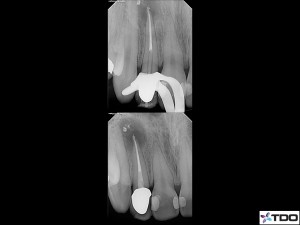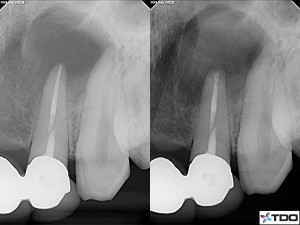Two teeth. Two different treatment plans.
The maxillary lateral incisor is the most common anterior tooth I treat in my practice. One of the reasons is that this tooth commonly has a distinctive distopalatal curvature in the apical 3mm of the canal. This increases the difficulty of maintaining the original canal path, which limits our ability to thoroughly treat the entire canal space. Let’s evaluate these two cases.
In the first case, a young woman presented to my practice with discomfort associated with tooth #7. This tooth was treated nearly a decade earlier prior to having a crown fabricated. Approximately one week prior to her visit, she had swelling and tenderness to palpation on the facial and palatal surface of tooth #7. Upon clinical evaluation, the tooth exhibited no significant periodontal probings and the aesthetics of the case were acceptable. However, the margins of the crown appeared less than ideal clinically. After evaluating the patient and discussing the case with the referring doctor, it was determined that tooth #7 will receive a new crown after endodontic therapy.
Pulpal Diagnosis: Previously treated
Periapical Diagnosis: Acute apical abscess
In the second case, a gentleman presented with discomfort associated with tooth #10. This tooth was treated one year earlier. He had swelling and tenderness to palpation on the facial and palatal surface of tooth #10. This had occurred prior to the endodontic treatment, and persisted off and on, even after the completion of initial endodontic therapy on tooth #10. Upon clinical evaluation, the tooth exhibited no significant periodontal probings and the aesthetics of the case were acceptable. The patient had a four unit bridge that had been fabricated several years prior and had good marginal adapation. After evaluating the patient and discussing the case with the referring doctor, it was determined that there was no plan to replace the restorative work on tooth #10 unless it was necessary.
Pulpal Diagnosis: Previously treated
Periapical Diagnosis: Acute apical abscess
Bias: An inclination of temperament or outlook; especially : a personal and sometimes unreasoned judgment.
The reason I post the definition of bias is because despite my best efforts, I bring my own biases to the table when establishing treatment plans. In both cases, I favored nonsurgical retreatment. In the first case, this treatment plan was accepted. New restorative was to be fabricated, and a multiple visit approach was recommended and accepted. In the second case, the span of the bridge and the potential for damage to the bridge was a risk the patient could not accept. In addition, because a post had been placed, this would have required the use of ultrasonic instrumentation. This increases the chance of porcelain fracture.
In the first case, tooth #7 was treated as seen below:
Over the course of three visits, the tooth was instrumented, medicated with calcium hydroxide, and obturated and restored with a fiber post and composite. A new crown has been fabricated.
In the second case, tooth #10 was treated surgically in a single visit as shown below:
Both perioperatively and postoperatively this patient is doing very well. The bridge remains intact and at present the symptoms have abated.
In both of these cases, the recalls will tell the story.
Treatment plans must always be crafted to fit the specific case. One size fits all has no place in the practice of endodontics and while challenging, we must be certain to account for our biases. We must be certain to engage our patients and our referring doctors in making treatment decisions that we can all agree on, ensuring the highest rate of predictable outcomes for all parties.


